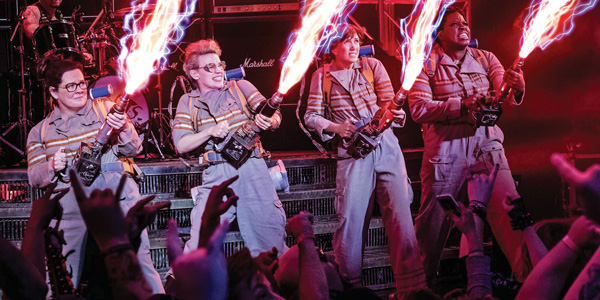News & Articles
Browse all content by date.

Ghostbusters (2016) should make male fans of the original movie uncomfortable – but not because the movie “ruins” the original. Ghostbusters (2016) is a critique of sexism and racism that suffused the original film and that remain active today. At the same time, it’s a fun film.
A Reminder of Ghostbusters (1984)
In the original Ghostbusters, the heroes must bring order to the city. New York is threatened by ghosts that are barely human (like Slimer, the signature ghost from the movie) or exoticized and sexualized (the allegedly Sumerian Zuul, who inhabits Sigourney Weaver). The spirits in Ghostbusters (1984) were opposed to “mainstream” white, male life – they were undisciplined and Other. It was the job of three white men (and the black man they hired for help) to discipline the ghosts and restore order.
The climax comes as all Ghostbusters aim their proton packs (being careful not to cross the streams, in very juvenile boy humor) at the monster at the same time. It’s a remarkable show of unity of purpose among men (in the theatrical version, where all four men are shown firing together) or a remarkable show of unity of purpose of white men (on the movie poster and on the edited versions for VHS, where Ernie Hudson was often cropped out).
Ghostbusters (2016) critiques nearly everything wrong with the original.
Protecting us from Historical Racism and Sexism
Ghostbusters (2016) opens with a tour of a historic home in New York. The guide identifies the “anti-Irish” fence and notes the spot where someone first invented the idea to enslave circus animals. The tour culminates in a story about a daughter who, it is alleged, killed nearly every member of the household and was, for her crime, imprisoned by her father in the basement without trial. (Trial would have possibly embarrassed her father, or possibly revealed that the daughter was not guilty. Better to lock her up until death.)
Within the first five minutes of the film, then, the central themes of racism, sexism and cruelty are established at the core of this movie.
In Ghostbusters (2016), Erin Gilbert, Abby Yates and Jillian Holtzmann (and the black woman they hired for help – this movie is stronger on repairing issues of gender than race) overcome the historical ghosts of sexism and racism. Villain Rowan North is unlocking the ghosts of the past using technology taken from our heroes.
For example, the new Ghostbusters kill the ghost of a Pilgrim, a fact that they vocalize to make sure the audience knows it. The villain sets up shop at a site of violence between settlers and native Americans. From the pilgrims through the nineteenth century robber barons who imprisoned their daughters in their basements, these Ghostbusters are protecting us from the legacy of historical racism and sexism.
Protecting us from Continuing Racism and Sexism
Today’s Ghostbusters also protect us from the continuing legacies of racism and sexism. Notably, Bill Murray’s character (Dr. Martin Heiss) exists only to question and deny the success of our three women scientists. Dan Akroyd’s character exists only to refuse to bring Erin Gilbert to Chinatown, because he won’t drive into that nonwhite neighborhood. Our two central cameos represent the forces of sexism and racism as they hold our heroines back.
The rest of the male cast does little better. The Mayor exists to publicly deny all the good work the Ghostbusters do, to tow their car and to arrest them to maintain the public image that they are phonies. The military and police are reduced to puppets. And why not? They are, after all, cut from the same cloth of sexism and racism – participants in the power structures of sexism and racism cannot resist sexism and racism alone. They need the Ghostbusters. And when our ladies win the day, their male secretary, Kevin Beckman, attempts to claim credit for their success.
The only male character who appears supportive is the cameo appearance by Ernie Hudson, the African American actor from the first movie. Hudson’s character admits the possibility of men as allies in the fight against racism and sexism.
Modeling Action against Racism and Sexism
For me, finally, one of the most significant moments of critique is in the ways that the Ghostbusters work together in each movie. In the original, the four men aim their proton packs as one.
The interplay in 2016 is chaotic, as the heroines support each other. Each shoots the ghost who looms behind their friend, watching their back. And, in the final moments, Erin dives into another dimension to recover Abby. The lesson here is not unity of purpose, a single vision domesticating Zuul (as in 1984), but teamwork and collaboration among individuals, each pursuing their own goals, working together to work against racism and sexism.
In 1984 (I was 12), I left the theater wanting a proton pack so I could bust some ghosts. “Busting,” after all, Ray Parker Junior said, “makes me feel good.” In 2016, I left the theater wanting to be a Ghostbuster by participating in rooting out the historical forces of racism and sexism that we accept as part of our lives today. And I want a proton pack.
– David Beard is Associate Professor of Rhetoric at the University of Minnesota Duluth, where he also directs the Master of Liberal Studies Program. He can be reached at dbeard@d.umn.edu.
| Tweet |

